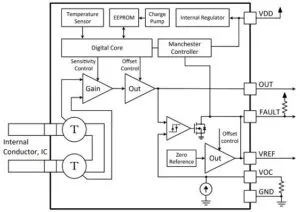
“Our TMR technology is enabling current sensors that are ten times faster and four times lower noise versus typical Hall-based products,” according to the company, which has called it ACS37100.
ACS37100 can “unlock the potential of fast-switching GaN and SiC FETs,” the company said. It is “tailored to the needs of electric vehicles and data centre power supplies”.
The sensor has a 1.2mΩ internal isolated current path, and comes in two versions: ±25A or ±50A.
Supply is a nominal 3.3V (10mA typ) and the output is an analogue voltage against a nominal 1.65V reference output. Gain is 52.8mV/A for the 25A version and 26.4mV/A for the 50A version.
Noise in either device is 26mArms across 10MHz bandwidth (25°C, 100pF load).
Although the signal path is analogue, it is overseen by a factory-programmed digital sub-system.
A resistor-adjustable over-current output is tripped if the input current exceeds its set-point in either direction.
UL 62368-1 (edition 3) isolation between the current path and the sensing circuit is 5kVrms (60s), 1,550Vdc (1,097Vrms) basic and 800Vdc (565Vrms) reinforced.
Creepage and clearance for the wide 16pin SOIC package are both 8mm.
Picking the ±25A version, offset error across temperature is ±8mV max across temperature (but see the data sheet as the reference output also has errors), and power supply sensitivity is ±1.1%.
Offset drift over life and temperature is typically ±3.5mV.
Operation is over -40 to +150°C and qualification is to AEC-Q100 automotive grade 0.
Find the ACS37100 data sheet on this allegro page
Taking an alternative route to isolated current sensing, and not matching 10MHz, Vishay recently introduced a 250kHz precision isolated differential amplifier for shunt resistors, with a nominal ±50mV input range .






